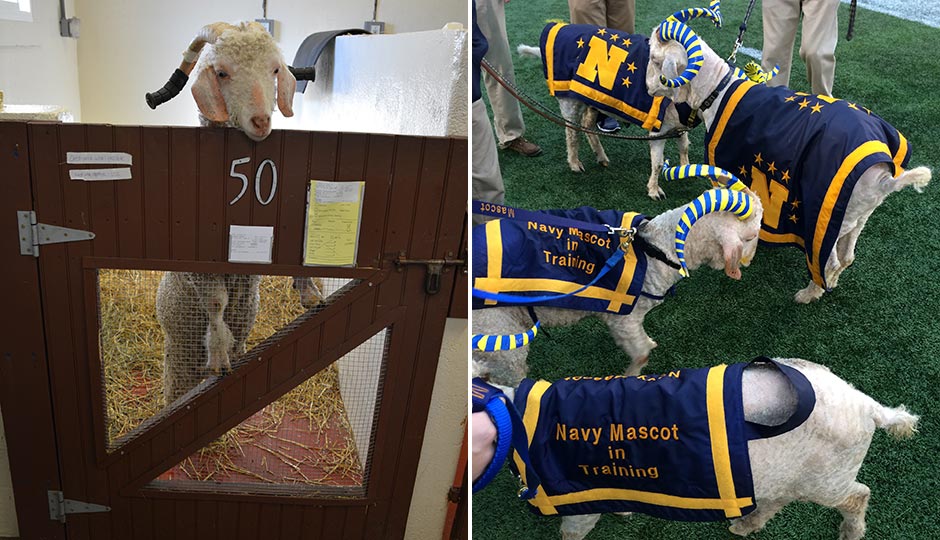How Penn’s Veterinary School Saved Navy’s Goat Mascot — Twice

Bill 36 (left); all the current Bills (right). Photos | University of Pennsylvania School of Veterinary Medicine
The 116th edition of the storied Army-Navy football game returns to Philly this Saturday after a brief hiatus in Maryland. Among the pigskin lore surrounding the (mostly) annual contest between the Black Knights and the Midshipmen: The first football helmet made its debut in the 1893 Army-Navy game. (It was fashioned by a shoemaker to protect the noggin of the man who would become Admiral Joseph Mason Reeves after doctors warned him another kick to the head could cause insanity.)
The teams may not be the powers they once were — they’ve both had winning records going into this contest only twice since 1963 — but the rivalry is. (The weight plates in the Navy weight room are engraved BEAT ARMY.) And a big part of that rivalry are the team’s mascots: the Army mule and the Navy goat. Or, rather, four goats — a tag team, Bill 33 and Bill 34, who at age 10 are nearing retirement, and their soon-to-be replacements, Bill 35 and Bill 36, 18-month-old Angora goat brothers donated by a Texas rancher to replace the current pair when they can no longer fulfill their duties, which mostly consist of looking really cute and letting kids pet them without biting. (The naming thing is tradition, not a failure of imagination; all but three Navy goat mascots have been named Bill dating back to 1900.)

Bill 36. Photo | University of Pennsylvania School of Veterinary Medicine
And it’s Bill 36 who’s the subject of a tragedy-turned-triumph out of the New Bolton Center, the large-animal arm of the University of Pennsylvania’s veterinary school. It seems that back in September, just as Bills 35 and 36 were scheduled to be presented to the Naval Academy leadership, 36 was experiencing a problem. He couldn’t, um, go. Number one. Big problem, according to the kids’ caregiver, whose identity and the location of whose farm are kept a state secret, since the Army-Navy rivalry also has a lengthy history of mascot-connected pranks. The caregiver began calling local vets, but none could get there quickly, so 36 was rushed to the New Bolton Center in Kennett Square. “We took Bill 35 with us, too,” the caregiver reports, “as they had only been with us a few weeks, and we felt he needed his wingman.”
At New Bolton, third-year resident Holly Stewart suspected obstructive urolithiasis, i.e., a blocked urethra, which is as painful as it sounds and is caused by mineral deposits. An ultrasound and rectal exam confirmed the diagnosis, the only treatment for which is emergency surgery. Stewart accordingly prepped 36 and — well, let’s quote the story in Penn Vet Extra, since we can hardly bear to read it:
During surgery, Stewart removed the necrotic tissue that had turned black at the end of the penis. She made an incision in the goat’s abdomen, opened up his bladder and removed mineral stones, flushing the urethra back and forth to make sure it was clear.
Yeah. So, with the help of an antibiotic and an anti-inflammatory medication, 36 made “a perfect recovery” and was all set for a long, leisurely career of cropping grass and not flinching at celebratory cannon fire. Um. Not quite.
In November, 36 was back at New Bolton, this time “hiding, drooling and regurgitating” and with labored breathing. Intern Holly Roessner and surgeon Louise Southwood questioned the caregiver and suspected possible poisoning via an azalea bush at the caregiver’s house. (Azaleas are toxic to goats.) 36 was started on IV fluids, and blood tests confirmed the presence of abnormalities consistent with azalea-eating. Roessner filled 36’s rumen with activated charcoal to keep the toxins from entering his bloodstream. Within a few hours, the vomiting had stopped, but, according to Roessner, “He still looked pretty sad.” A painkiller perked him up considerably, and by the following day, 36 was on the mend. (Had 36 ingested more of the plant, New Bolton might have removed the leaves from his stomach via surgery. If you’ve got goats, for God’s sake, keep them away from azaleas, rhododendrons and mountain laurel.)
You can see 36 and his less troublesome, if less adventurous, fellow goats, 33, 34 and 35, on the sidelines of the Army-Navy game on Saturday. Meantime, New Bolton is bracing for possible reports of ailing flying reindeer a few weeks from now.
Follow @SandyHingston on Twitter.


